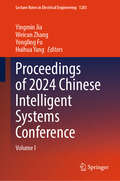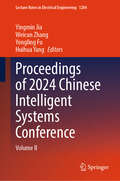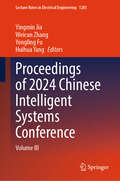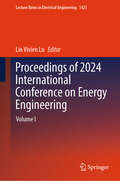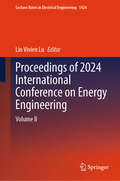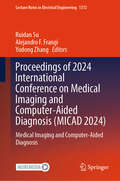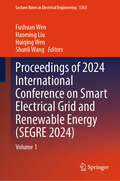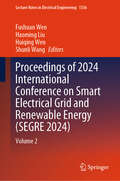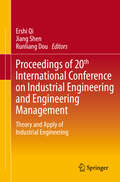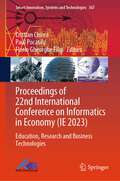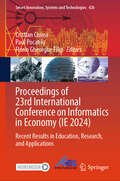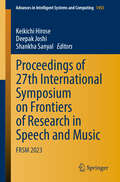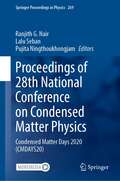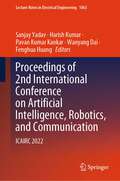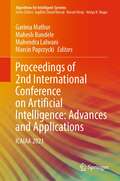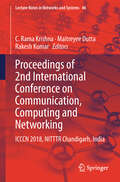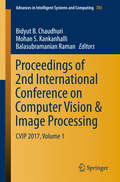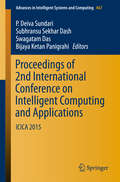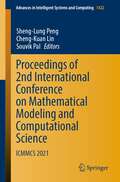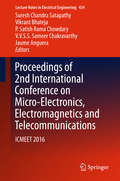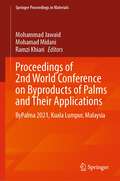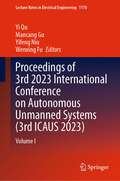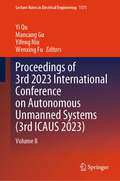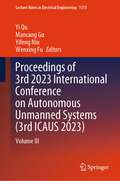- Table View
- List View
Proceedings of 2024 Chinese Intelligent Systems Conference: Volume I (Lecture Notes in Electrical Engineering #1283)
by Yingmin Jia Weicun Zhang Yongling Fu Huihua YangThis book constitutes the proceedings of the 20th Chinese Intelligent Systems Conference, CISC 2024, which was held on October 26–27, 2024, in Guilin, Guangxi, China. The book focuses on new theoretical results and techniques in the field of intelligent systems and control. This is achieved by providing in-depth studies of a number of important topics such as multi-agent systems, complex networks, intelligent robots, complex systems theory and swarm behaviour, event-driven and data-driven control, robust and adaptive control, big data and brain science, process control, intelligent sensors and detection technology, deep learning and learning control, navigation and control of flying vehicles, and so on. The book is particularly suitable for readers interested in learning intelligent systems and control and artificial intelligence. The book can benefit researchers, engineers and graduate students.
Proceedings of 2024 Chinese Intelligent Systems Conference: Volume II (Lecture Notes in Electrical Engineering #1284)
by Yingmin Jia Weicun Zhang Yongling Fu Huihua YangThis book constitutes the proceedings of the 20th Chinese Intelligent Systems Conference, CISC 2024, which was held on October 26–27, 2024, in Guilin, Guangxi, China. The book focuses on new theoretical results and techniques in the field of intelligent systems and control. This is achieved by providing in-depth studies of a number of important topics such as multi-agent systems, complex networks, intelligent robots, complex systems theory and swarm behaviour, event-driven and data-driven control, robust and adaptive control, big data and brain science, process control, intelligent sensors and detection technology, deep learning and learning control, navigation and control of flying vehicles, and so on. The book is particularly suitable for readers interested in learning intelligent systems and control and artificial intelligence. The book can benefit researchers, engineers and graduate students.
Proceedings of 2024 Chinese Intelligent Systems Conference: Volume III (Lecture Notes in Electrical Engineering #1285)
by Yingmin Jia Weicun Zhang Yongling Fu Huihua YangThis book constitutes the proceedings of the 20th Chinese Intelligent Systems Conference, CISC 2024, which was held on October 26–27, 2024, in Guilin, Guangxi, China. The book focuses on new theoretical results and techniques in the field of intelligent systems and control. This is achieved by providing in-depth studies of a number of important topics such as multi-agent systems, complex networks, intelligent robots, complex systems theory and swarm behaviour, event-driven and data-driven control, robust and adaptive control, big data and brain science, process control, intelligent sensors and detection technology, deep learning and learning control, navigation and control of flying vehicles, and so on. The book is particularly suitable for readers interested in learning intelligent systems and control and artificial intelligence. The book can benefit researchers, engineers and graduate students.
Proceedings of 2024 International Conference on Energy Engineering: Volume I (Lecture Notes in Electrical Engineering #1425)
by Lin Vivien LuThe International Conference on Energy Engineering 2024 is dedicated into the forefront of energy innovation. Explore groundbreaking research across seven key tracks, including Renewable Energy, Clean Energy Technologies, Intelligent and Electrical Energy Systems, Energy Efficiency, Energy Storage, Energy Policy and Sustainability, and Mitigation Technologies. Discover cutting-edge solutions and strategies to propel sustainable energy production, enhance system efficiency, and address pressing environmental challenges. This comprehensive resource caters to researchers, industry professionals, policymakers, and stakeholders invested in shaping the future of energy technology and policy.
Proceedings of 2024 International Conference on Energy Engineering: Volume II (Lecture Notes in Electrical Engineering #1426)
by Lin Vivien LuThe International Conference on Energy Engineering 2024 is dedicated into the forefront of energy innovation. Explore groundbreaking research across seven key tracks, including Renewable Energy, Clean Energy Technologies, Intelligent and Electrical Energy Systems, Energy Efficiency, Energy Storage, Energy Policy and Sustainability, and Mitigation Technologies. Discover cutting-edge solutions and strategies to propel sustainable energy production, enhance system efficiency, and address pressing environmental challenges. This comprehensive resource caters to researchers, industry professionals, policymakers, and stakeholders invested in shaping the future of energy technology and policy.
Proceedings of 2024 International Conference on Medical Imaging and Computer-Aided Diagnosis: Medical Imaging and Computer-Aided Diagnosis (Lecture Notes in Electrical Engineering #1372)
by Alejandro F. Frangi Ruidan Su Yudong ZhangThis book aims to provide a collaborative platform for leading technology minds to exchange insights, foster interdisciplinary dialogue, and propel advancements in both medical imaging and computer-aided diagnosis. As technology evolves, a plethora of state-of-the-art human imaging devices have made remarkable strides in the medical field, transforming diagnostic and treatment standards. Concurrently, there is a growing emphasis on extracting and deciphering extensive information from medical images, spurring the demand for innovative solutions. The fusion of digital image processing and computer vision technologies has paved the way for computer-aided diagnosis (CAD), a pivotal player in disease analysis. This conference extends a warm invitation to researchers, scholars, engineers, scientists, industry leaders, and graduate students active in these fields. Through diverse participation formats, including compelling poster presentations and enlightening oral sessions, attendees will gain profound insights into the intricate interplay between these realms. This book showcases the latest technological breakthroughs, forging valuable connections and envisioning future applications.
Proceedings of 2024 International Conference on Smart Electrical Grid and Renewable Energy: Volume 1 (Lecture Notes in Electrical Engineering #1363)
by Fushuan Wen Shunli Wang Haoming Liu Huiqing WenThe proceedings presents a comprehensive collection of carefully selected papers from the 2nd International Conference on Smart Electrical Grid and Renewable Energy (SEGRE 2024). With a strong emphasis on electrical engineering, smart grid technology, and green technology, this work serves as a valuable resource for researchers, experts, professionals, and practitioners in the fields of electrical grids and renewable energy. The conference aims to create knowledge exchange, where participants can present their cutting-edge research findings, showcase their latest research project outcomes, and engage in insightful discussions to share their views and experiences.
Proceedings of 2024 International Conference on Smart Electrical Grid and Renewable Energy: Volume 2 (Lecture Notes in Electrical Engineering #1336)
by Fushuan Wen Shunli Wang Haoming Liu Huiqing WenThe proceedings presents a comprehensive collection of carefully selected papers from the 2nd International Conference on Smart Electrical Grid and Renewable Energy (SEGRE 2024). With a strong emphasis on electrical engineering, smart grid technology, and green technology, this work serves as a valuable resource for researchers, experts, professionals, and practitioners in the fields of electrical grids and renewable energy. The conference aims to create knowledge exchange, where participants can present their cutting-edge research findings, showcase their latest research project outcomes, and engage in insightful discussions to share their views and experiences.
Proceedings of 20th International Conference on Industrial Engineering and Engineering Management
by Ershi Qi Jiang Shen Runliang DouThe International Conference on Industrial Engineering and Engineering Management is sponsored by the Chinese Industrial Engineering Institution, CMES, which is the only national-level academic society for Industrial Engineering. The conference is held annually as the major event in this arena. Being the largest and the most authoritative international academic conference held in China, it provides an academic platform for experts and entrepreneurs in the areas of international industrial engineering and management to exchange their research findings. Many experts in various fields from China and around the world gather together at the conference to review, exchange, summarize and promote their achievements in the fields of industrial engineering and engineering management. For example, some experts pay special attention to the current state of the application of related techniques in China as well as their future prospects, such as green product design, quality control and management, supply chain and logistics management to address the need for, amongst other things low-carbon, energy-saving and emission-reduction. They also offer opinions on the outlook for the development of related techniques. The proceedings offers impressive methods and concrete applications for experts from colleges and universities, research institutions and enterprises who are engaged in theoretical research into industrial engineering and engineering management and its applications. As all the papers are of great value from both an academic and a practical point of view, they also provide research data for international scholars who are investigating Chinese style enterprises and engineering management.
Proceedings of 22nd International Conference on Informatics in Economy: Education, Research and Business Technologies (Smart Innovation, Systems and Technologies #367)
by Florin Gheorghe Filip Cristian Ciurea Paul PocatiluThis book includes high-quality research papers presented at 22nd International Conference on Informatics in Economy (IE 2023), which is held in Bucharest, Romania, during May 2023. This book covers research results in business informatics and related computer science topics, such as IoT, mobile-embedded and multimedia solutions, e-society, enterprise and business solutions, databases and big data, artificial intelligence, data mining and machine learning, quantitative economics.
Proceedings of 23rd International Conference on Informatics in Economy: Recent Results in Education, Research, and Applications (Smart Innovation, Systems and Technologies #426)
by Florin Gheorghe Filip Cristian Ciurea Paul PocatiluThis book includes high-quality research papers presented at 23rd International Conference on Informatics in Economy (IE 2024), which is held in Bucharest, Romania, during May 2024. This book covers research results in business informatics and related computer science topics, such as IoT, mobile-embedded and multimedia solutions, e-society, enterprise and business solutions, databases and big data, artificial intelligence, data mining and machine learning, quantitative economics.
Proceedings of 27th International Symposium on Frontiers of Research in Speech and Music: FRSM 2023 (Advances in Intelligent Systems and Computing #1455)
by Keikichi Hirose Shankha Sanyal Deepak JoshiThis book features original papers from 27th International Symposium on Frontiers of Research in Speech and Music (FRSM 2023), jointly organized by Sardar Vallabhbhai National Institute of Technology, Surat, India, and Sir C.V. Raman Centre for Physics and Music, Jadavpur University, Kolkata, India, during 4–5 August 2023. The book is organized into four main sections, considering both technological advancement and interdisciplinary nature of speech, music, language and their applications. The first section includes chapters related to computational, modelling and cognitive aspects of the speech signal. The second part contains chapters covering the foundations of both vocal and instrumental music processing with the signal, computational and cognitive aspects. The third section relates to the variety of research being done in the peripheral areas of languages and linguistics with special focus on regional languages of India. A lot of research is being performed within the speech and music information retrieval domain which is potentially interesting for most users of computers and the Internet. Therefore, the fourth and final section is dedicated to the chapters related to multidisciplinary applications of speech and music signal processing.
Proceedings of 28th National Conference on Condensed Matter Physics: Condensed Matter Days 2020 (CMDAYS20) (Springer Proceedings in Physics #269)
by Ranjith G. Nair Lalu Seban Pujita NingthoukhongjamThis book features selected works presented in the 28th National Conference on Condensed Matter Physics, “Condensed Matter Days (CMDAYS) 2020”, which was held from December 11th to 13th December 2020. The conference brought together seasoned experts and upcoming researchers from all over India to share their research and ideas in the field of condensed matter physics. This book is a glimpse into the works and ideas that were discussed and presented at the conference. It includes works on diverse fields from nanomaterials to fuel cells, photocatalysis to ferromagnetism, application studies to fundamental studies.
Proceedings of 2nd International Conference on Artificial Intelligence, Robotics, and Communication: ICAIRC 2022 (Lecture Notes in Electrical Engineering #1063)
by Harish Kumar Sanjay Yadav Pavan Kumar Kankar Wanyang Dai Fenghua HuangThis volume comprises the select proceedings of the 2nd International Conference on Artificial Intelligence, Robotics, and Communication (ICAIRC 2022). The content focuses on big data and cloud computing and the application of artificial intelligence, robotics and engineering, the Internet of things, and sensor technology. Some of the topics covered include robot control, perception systems, dexterous manipulation, robot sensing, and data fusion, technology architecture of IoT, information analysis and processing of IoT, dynamic resource supply and consumption, IoT chips and sensors, industrial IoT, and Big Data, the architecture of Big Data, security and privacy of Big Data, management and operation of cloud computing, etc. This volume will be of interest to those working in academia and industry in the fields of computation, communication, and engineering.
Proceedings of 2nd International Conference on Artificial Intelligence: ICAIAA 2021 (Algorithms for Intelligent Systems)
by Marcin Paprzycki Mahesh Bundele Garima Mathur Mahendra LalwaniThis book gathers outstanding research papers presented in the 2nd International Conference on Artificial Intelligence: Advances and Application (ICAIAA 2021), held in Poornima College of Engineering, Jaipur, India during 27-28 March 2021. This book covers research works carried out by various students such as bachelor, master and doctoral scholars, faculty and industry persons in the area of artificial intelligence, machine learning, deep learning applications in healthcare, agriculture, business, security, etc. It will also cover research in core concepts of computer networks, intelligent system design and deployment, real time systems, WSN, sensors and sensor nodes, SDN, NFV, etc.
Proceedings of 2nd International Conference on Communication, Computing and Networking: ICCCN 2018, NITTTR Chandigarh, India (Lecture Notes in Networks and Systems #46)
by Rakesh Kumar C. Rama Krishna Maitreyee DuttaThe book provides insights from the 2nd International Conference on Communication, Computing and Networking organized by the Department of Computer Science and Engineering, National Institute of Technical Teachers Training and Research, Chandigarh, India on March 29–30, 2018. The book includes contributions in which researchers, engineers, and academicians as well as industrial professionals from around the globe presented their research findings and development activities in the field of Computing Technologies, Wireless Networks, Information Security, Image Processing and Data Science. The book provides opportunities for the readers to explore the literature, identify gaps in the existing works and propose new ideas for research.
Proceedings of 2nd International Conference on Computer Vision & Image Processing: Cvip 2017, Volume 2 (Advances In Intelligent Systems And Computing #704)
by Mohan S. Kankanhalli Balasubramanian Raman Bidyut B. ChaudhuriThe book provides insights into the Second International Conference on Computer Vision & Image Processing (CVIP-2017) organized by Department of Computer Science and Engineering of Indian Institute of Technology Roorkee. The book presents technological progress and research outcomes in the area of image processing and computer vision. The topics covered in this book are image/video processing and analysis; image/video formation and display; image/video filtering, restoration, enhancement and super-resolution; image/video coding and transmission; image/video storage, retrieval and authentication; image/video quality; transform-based and multi-resolution image/video analysis; biological and perceptual models for image/video processing; machine learning in image/video analysis; probability and uncertainty handling for image/video processing; motion and tracking; segmentation and recognition; shape, structure and stereo.
Proceedings of 2nd International Conference on Intelligent Computing and Applications
by Bijaya Ketan Panigrahi Swagatam Das Subhransu Sekhar Dash P. Deiva SundariSecond International Conference on Intelligent Computing and Applications was the annual research conference aimed to bring together researchers around the world to exchange research results and address open issues in all aspects of Intelligent Computing and Applications. The main objective of the second edition of the conference for the scientists, scholars, engineers and students from the academia and the industry is to present ongoing research activities and hence to foster research relations between the Universities and the Industry. The theme of the conference unified the picture of contemporary intelligent computing techniques as an integral concept that highlights the trends in computational intelligence and bridges theoretical research concepts with applications. The conference covered vital issues ranging from intelligent computing, soft computing, and communication to machine learning, industrial automation, process technology and robotics. This conference also provided variety of opportunities for the delegates to exchange ideas, applications and experiences, to establish research relations and to find global partners for future collaboration.
Proceedings of 2nd International Conference on Mathematical Modeling and Computational Science: ICMMCS 2021 (Advances in Intelligent Systems and Computing #1422)
by Sheng-Lung Peng Souvik Pal Cheng-Kuan LinThe conference proceeding of ICMMCS 2021 presents most recent scientific and technological advances in the fields of engineering mathematics and computational science to strengthen the links in the scientific community. It is a collection of high-quality, peer-reviewed research papers presented at the Second International Conference on Mathematical Modeling and Computational Science (ICMMCS 2021), held online during October 29–30, 2021. The topics covered in the book are mathematical logic and foundations, numerical analysis, neural networks, fuzzy set theory, coding theory, higher algebra, number theory, graph theory and combinatory, computation in complex networks, calculus, differential educations and integration, application of soft computing, knowledge engineering, machine learning, artificial intelligence, big data and data analytics, high-performance computing, network and device security, Internet of Things (IoT).
Proceedings of 2nd International Conference on Micro-Electronics, Electromagnetics and Telecommunications
by Suresh Chandra Satapathy Vikrant Bhateja P. Satish Rama Chowdary V. V. S. S. Sameer Chakravarthy Jaume AngueraThe book is a collection of best papers presented in the Second International Conference on Microelectronics Electromagnetics and Telecommunication (ICMEET 2016), an international colloquium, which aims to bring together academic scientists, researchers and research scholars to discuss the recent developments and future trends in the fields of microelectronics, electromagnetics and telecommunication. Microelectronics research investigates semiconductor materials and device physics for developing electronic devices and integrated circuits with data/energy efficient performance in terms of speed, power consumption, and functionality. The book discusses various topics like analog, digital and mixed signal circuits, bio-medical circuits and systems, RF circuit design, microwave and millimeter wave circuits, green circuits and systems, analog and digital signal processing, nano electronics and giga scale systems, VLSI circuits and systems, SoC and NoC, MEMS and NEMS, VLSI digital signal processing, wireless communications, cognitive radio, and data communication.
Proceedings of 2nd International Conference on Smart Computing and Cyber Security: Strategic Foresight, Security Challenges and Innovation (SMARTCYBER 2021) (Lecture Notes in Networks and Systems #395)
by Prasant Kumar Pattnaik Mangal Sain Ahmed A. Al-AbsiThis book presents high-quality research papers presented at the Second International Conference on Smart Computing and Cyber Security: Strategic Foresight, Security Challenges and Innovation (SMARTCYBER 2021) held during June 16–17, 2021, in the Department of Smart Computing, Kyungdong University, Global Campus, South Korea. The book includes selected works from academics and industrial experts in the field of computer science, information technology, and electronics and telecommunication. The content addresses challenges of cyber security.
Proceedings of 2nd World Conference on Byproducts of Palms and Their Applications: ByPalma 2021, Kuala Lumpur, Malaysia (Springer Proceedings in Materials #19)
by Mohammad Jawaid Mohamad Midani Ramzi KhiariThis book presents the selected papers presented at the 2nd World Conference on Byproducts of Palms and their Applications (ByPalma 2021), held as a virtual conference on September 28–30, 2021. The conference focused on the byproducts of palm plantations around the globe and their current and potential applications. It provided an interdisciplinary platform for leading academic scientists, researchers, artisans, entrepreneurs and industry professionals as well as palm growers to exchange recent developments, technologies, innovations, trends, concerns, challenges, and opportunities, related to palm by-products R&D, manufacturing, and crafts. As a reference, it will be of interest to students, scientists, engineers, government officials, and industrial practitioners.
Proceedings of 3rd 2023 International Conference on Autonomous Unmanned Systems: Volume I (Lecture Notes in Electrical Engineering #1170)
by Yi Qu Mancang Gu Yifeng Niu Wenxing FuThis book includes original, peer-reviewed research papers from the 3rd ICAUS 2023, which provides a unique and engaging platform for scientists, engineers and practitioners from all over the world to present and share their most recent research results and innovative ideas. The 3rd ICAUS 2023 aims to stimulate researchers working in areas relevant to intelligent unmanned systems. Topics covered include but are not limited to: Unmanned Aerial/Ground/Surface/Underwater Systems, Robotic, Autonomous Control/Navigation and Positioning/ Architecture, Energy and Task Planning and Effectiveness Evaluation Technologies, Artificial Intelligence Algorithm/Bionic Technology and their Application in Unmanned Systems.The papers presented here share the latest findings in unmanned systems, robotics, automation, intelligent systems, control systems, integrated networks, modelling and simulation. This makes the book a valuable resource for researchers, engineers and students alike.
Proceedings of 3rd 2023 International Conference on Autonomous Unmanned Systems: Volume II (Lecture Notes in Electrical Engineering #1171)
by Yi Qu Mancang Gu Yifeng Niu Wenxing FuThis book includes original, peer-reviewed research papers from the 3rd ICAUS 2023, which provides a unique and engaging platform for scientists, engineers and practitioners from all over the world to present and share their most recent research results and innovative ideas. The 3rd ICAUS 2023 aims to stimulate researchers working in areas relevant to intelligent unmanned systems. Topics covered include but are not limited to: Unmanned Aerial/Ground/Surface/Underwater Systems, Robotic, Autonomous Control/Navigation and Positioning/ Architecture, Energy and Task Planning and Effectiveness Evaluation Technologies, Artificial Intelligence Algorithm/Bionic Technology and their Application in Unmanned Systems.The papers presented here share the latest findings in unmanned systems, robotics, automation, intelligent systems, control systems, integrated networks, modelling and simulation. This makes the book a valuable resource for researchers, engineers and students alike.
Proceedings of 3rd 2023 International Conference on Autonomous Unmanned Systems: Volume III (Lecture Notes in Electrical Engineering #1173)
by Yi Qu Mancang Gu Yifeng Niu Wenxing FuThis book includes original, peer-reviewed research papers from the 3rd ICAUS 2023, which provides a unique and engaging platform for scientists, engineers and practitioners from all over the world to present and share their most recent research results and innovative ideas. The 3rd ICAUS 2023 aims to stimulate researchers working in areas relevant to intelligent unmanned systems. Topics covered include but are not limited to: Unmanned Aerial/Ground/Surface/Underwater Systems, Robotic, Autonomous Control/Navigation and Positioning/ Architecture, Energy and Task Planning and Effectiveness Evaluation Technologies, Artificial Intelligence Algorithm/Bionic Technology and their Application in Unmanned Systems.The papers presented here share the latest findings in unmanned systems, robotics, automation, intelligent systems, control systems, integrated networks, modelling and simulation. This makes the book a valuable resource for researchers, engineers and students alike.
